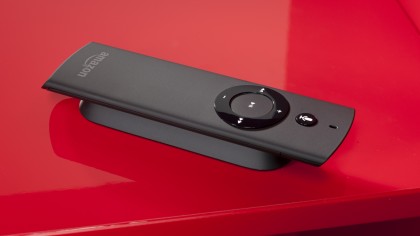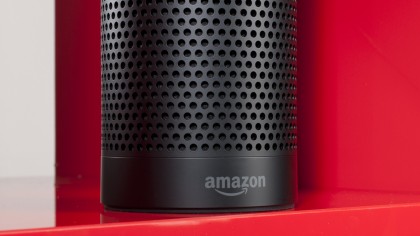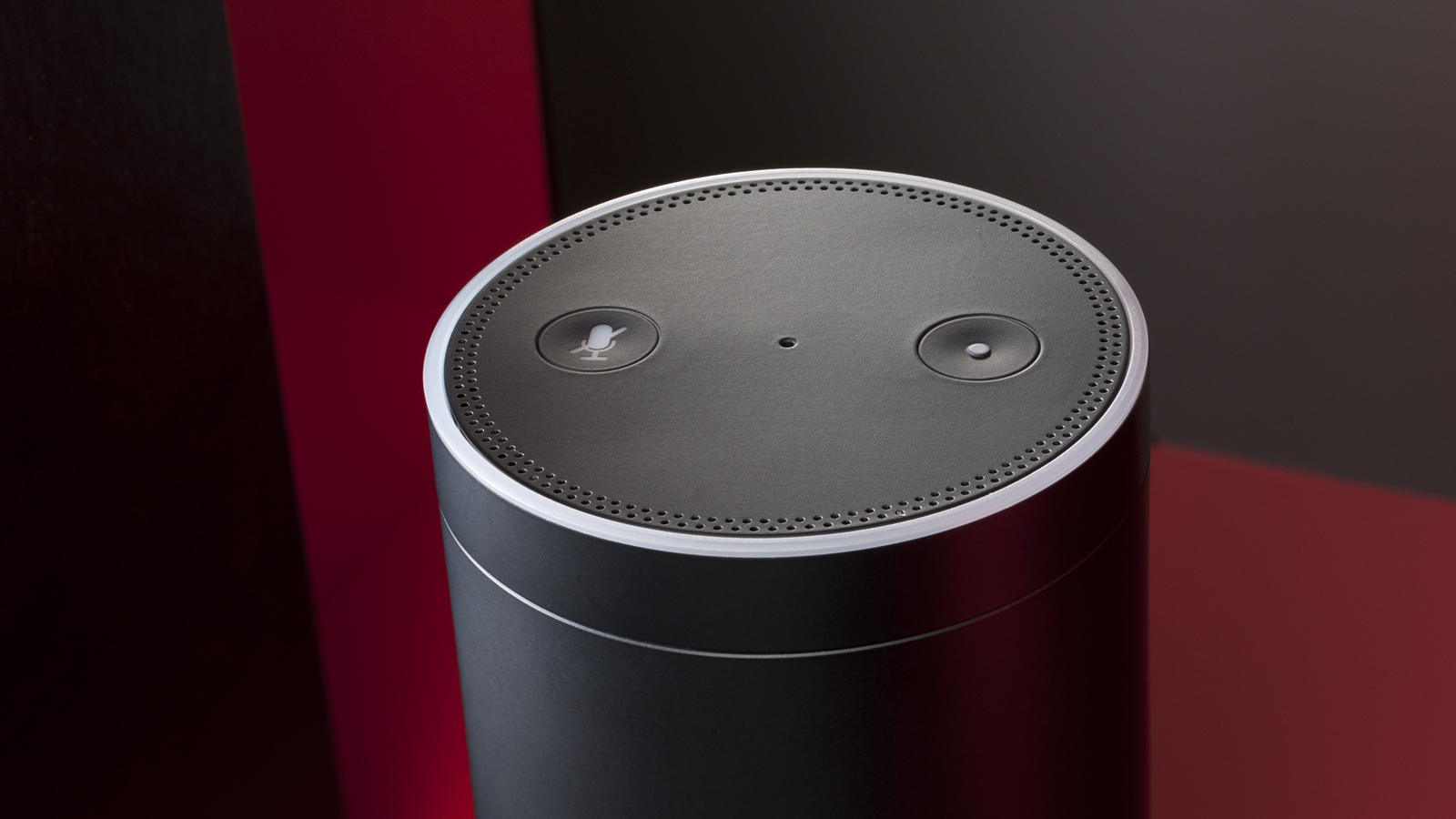TechRadar Verdict
As purely a Bluetooth speaker, the Echo leaves a lot to be desired. Paired with a natural, engrossing AI, however, Amazon's grand experiment in artificial intelligence is one of the most interesting gadgets of recent years.
Pros
- +
Intelligent voice recognition
- +
Large ecosystem and growing
- +
Well built
Cons
- -
Caters to Prime
- -
Lackluster sound quality
- -
Multi-user support lacking
Why you can trust TechRadar
The Amazon Echo was the company’s first foray into the smart speaker space way back in 2014. It was the device to first kick off Amazon’s voice-activated smart home ambitions, and despite the fact the Echo range is constantly being updated and expanded, the Echo is still a core product and a great option for dipping your toe into the modern-day smart home.
One of the main reasons we still recommend the original Echo is that it’s still receiving new functionality on a regular basis, like voice calling and messaging, which first came to the Echo Show.
Back in 2014, when we had our first conversation with Alexa, a personal assistant built in to the $179 Amazon Echo (£150, around AU$230), it wasn't very deep. Instead we ended up asking Alexa stupid questions, having her shuffle music and asking about mundane topics like the weather or the time. The earliest conversations were simple, almost child-like.
As the months went on, the conversations got deeper as the team at Amazon added more functionality and Alexa became smarter and more helpful. Soon we could talk about sports, or what we had coming up on our calendar. Alexa could give sporting scores, or tell us how we were already late for a meeting.
It wasn't much longer before Alexa could read audiobooks, play our favorite podcasts and control some of the other smart devices in our homes. You can now ask Alexa about where you should go for Chinese food, or when the grocery store closes thanks to Yelp integration. Alexa can even now play music from services other than Amazon Prime like Spotify or Pandora in the US.
We’re watched Amazon Echo grow up from a novelty to a smart AI over the past few years. We've used products for years – iPods or Xboxs for example – but this is the first time that we've witnessed something evolve so much without ever needing a guiding hand.
If you’re still not convinced, we’ve heard many people say that Amazon Echo is something you don't know you want until you have it, and something you don't miss until it's gone. So with that in mind, find out what we thought of the Amazon Echo when we first got our hands on it.
Sign up for breaking news, reviews, opinion, top tech deals, and more.
- Five years after the first Amazon Echo was released, Amazon now has a whole host of new smart home products to choose from, including the all-new Amazon Echo (2019) and the Amazon Echo Studio.
Amazon Echo (2014) FAQ: quick questions answered
Is there a monthly fee for Echo?
No, there’s no monthly fee. You just need to buy the Echo and have an Amazon account. You’ll then need to get the Amazon Echo app, which is also free.
However, if you’re an Amazon Prime member you’ll get some added benefits, like access to Amazon Music through your Echo.
What does an Amazon Echo do?
Think of the Amazon Echo as your own personal assistant. We’re not at the stage where our tech can physically help us run our homes, but it can do everything else. So you can ask the Echo’s voice assistant, Alexa, to answer questions about the time, general knowledge, traffic, what the weather is going to be like and everything else that might help your day run a bit smoother.
Thanks to smart home tech all connecting up, you can also use your Echo to control other devices that you might have in your home. So let’s say you have a Philips Hue lightbulb, for example, the Echo can control that too. You’d just need to say “Alexa, turn off the bulb.”
That’s just the beginning. The Echo has a whole host of ‘skills’ which you can think of as separate apps and things it can do for you, from playing games to controlling other tech to waking you up in the morning.
What’s the difference between Echo and Alexa?
The Echo is the name of the smart speaker, Alexa is the smart assistant inside.
What’s the difference between Amazon Echo and Amazon Dot?
The Amazon Echo is the original smart speaker from Amazon. It has Alexa built-in and can play good quality music. The Dot is the same thing, but smaller. The main difference is that the Dot’s speaker isn’t as good as Echo’s. So if you want to play music, get an Echo.
Does the Echo require Alexa?
Yes. Alexa is what makes your Echo smart. Think of her as your own smart assistant and the brains behind the hardware. You ask her to do things and help you with things throughout the day, from “Alexa, what will the weather be like later?” to “Alexa, switch on the lights please.”
You don’t need to do anything extra to get Alexa, the voice assistant comes built-in to Amazon’s Echo range of smart speakers.
Design
It's easy to mistake the Echo for a portable dehumidifier. It's all matte black exterior and 9.25 x 3.27 inch cylindrical shape gives it the kind of camouflage you'd expect from an appliance.

Another difference between the Echo and other portable speakers is that the Echo isn't exactly portable. It needs to be plugged in and connected to Wi-Fi at all times. (Which, considering the six-foot power cable, can be a bit of a struggle.)
And this decision makes sense when you give it some thought. How could an always-on microphone hear you if it runs out of power? It couldn't. Moreover, how would it send your voice to Amazon servers without a connection to the internet? Again, not going to happen.
Sure, it's a hassle to always be connected, but Wi-Fi networks are a dime-a-dozen these days.
On top of the canister are two buttons, mute and listen, while the top ring rotates to raise or lower volume.
Aside the volume ring is the light ring. This glows blue when you summon Alexa, flashes when it is searching for an answer to your query and glows red when you press the Mute button, so you really know that it isn't listening.
In the US the Echo comes with a traditional remote identical to the one that comes with the Amazon Fire TV, or can be controlled from your phone via the Amazon Echo App for those concerned with not having physical buttons to press.

Speaking of which, the app isn't the most fleshed-out companion app we've ever used, and can feel pretty barren in comparison to the Amazon Fire TV storefront. We found a few of the selections relatively useful – controlling radio stations via the app is painless compared with asking Alexa to do it – but the design can look and feel a little lacking compared to the competition.
Along the bottom of the Echo is a 360-degree speaker grille that gives it some surprisingly room-filling sound along with a small, white Amazon logo.
The speaker produces omni-directional sound, so it doesn't really matter whereabouts it sits - whether on a shelf or as a centrepiece on your mantlepiece the sound you get from it is decent though not mind blowing.
Also contained within the chassis is an array of seven microphones, all of which act as ears for the Amazon Echo. They are packed with noise-cancelling technology, so when you say 'Alexa' - the wake word for the Echo - it will be heard, even if you have a soft voice, are in a noisy room, or are playing music - which is likely given the Echo is primarily a speaker.
Simple setup
And you will be saying Alexa a lot - although your reasons of which will be different for every person that uses it.
If you are lost for words at the beginning - and we were, given speaking to a speaker does feel a little unnatural at first - then don't panic. Amazon offers up a small list of things to say to your device when you get it set up, with a selection of hints that are on the box itself and in handy card form. The list isn't extensive but it is enough to get you started. There's also a Things To Try section on the Alexa app, which is a bit more extensive.
But before you can speak to it, you need to set it up. Thankfully this is a fairly simple process.
To connect it to your home network, you need to download the Alexa companion app on Android or iOS and follow the instructions, with your Amazon Echo plugged in.
This app isn't just for Amazon Echo, so if you have a Fire TV or any other Amazon-connected device then these will appear in the Alexa app.The app prompted us to manually connect the Echo through our wireless settings (by choosing Amazon in the settings), but it may ask you to hold the action button on the device for five seconds.
Once done, select your Wi-Fi network, enter the passwords and you should be in, with a confirmation message appearing in the app. This took under two minutes for us to do.
Sound quality
While the Echo can crank the volume, the quality of the sound near its upper and lower limits leaves a lot to be desired.
Testing took place in two environments: a small, 12 x 14 ft bedroom and much larger 20 x 15 ft living room. The confined space, as you might expect, benefitted the quieter volume levels and completely muddled anything above 7. Given enough space, sound only faltered at the highest levels, 9 and 10, but Alexa had a tougher time picking up commands. At least the balance around volumes 4-6 were spot on.

With any other Bluetooth speaker, these kinds of problems would've been grounds for a failing grade. But the fact that Alexa not only needs to produce a lot of noise, but be able to hear over it as well, is good reason to cut it some slack.
Streaming music selection
Now that I've sold you on its music-playing capabilities (not), you're probably thinking, "but gee, what can I play on it?"
The Echo supports Spotify, TuneIn and, if you're a Prime subscriber, Amazon Prime Music. If you're in the US, the Echo also supports Pandora as well.
But, if all else fails or you don't feel like re-buying songs you've paid for on other services, there's one last-ditch effort to get your music: Amazon will actually allow you to import 250 songs to the cloud from your personal collection for free. This may not sound like a lot, but for those of us with one or two go-to playlists, it compensates for any slight inconvenience it caused to add them.
When it works, Alexa feels like the talking computer that sci-fi has been imagining for the last 50 years. Conversations can happen in informal language, and queries are picked up by natural cues instead of awkward syntax. Both "Alexa tell me about razors" and "Alexa, what is a razor?" lead me to the same answer, and feel completely natural when said out loud.
Alexa Skills
Alexa really comes to life when you start adding Skills to it. In the US, Amazon is boasting that there's now over 3,000 skills available for Alexa. It's a nice number but dig into this and you can see that it's quantity over quality.
In the UK, at our count, there's around 2,800 Skills available - a great number and not bad for something that's just launched in the UK but, again, that number is flattering. Many of the skills are fairly useless add-ons that you will probably use once then grow bored of them.
We tried a number of them and they vary in quality. Some of them are really simple but great to use. Guitar Tuner worked well: load this up and it will help you tune up your guitar's strings in no time. Jamie Oliver's Skill is good too. We asked it how to make a decent bolognese and it emailed us the recipe straight way. It would have been more helpful to have this narrated through the Echo but it was useful all the same.
The majority of Skills aren't great though, unless you want to learn facts about cats, snakes, coffee, chameleons… this list unfortunately goes on and on.
In amongst the filler there are some fantastic Skills available, especially if you have already taken some steps to making your home smart.
We have Hive installed and linking this with Amazon Echo was a revelation. Having the ability to turn on your smart lights with your voice never grows old and it feels instinctive to ask Alexa to turn your heating up by a degree or two. Echo will also link in with Nest, Netatmo, Philips Hue, SmartThings and Honeywell products. There's no doubt that the smart home is where Amazon Echo thrives - it just works so well. And it won't end here, either - as Sonos has announced that it will offer integration in 2017.
When you do choose a Skill, however, there are some inconsistencies with how you ask Alexa for that particular information. For instance, once we set up Hive to work with Alexa, we never had to ask Alexa to launch Hive, just say things like: "Alexa, dim the dining room lights 50%". That would dim the lights no problem. But, when it came to asking for travel information, we had to say: "Alexa, launch National Rail" and then ask about our commute. This adds a bit of a barrier that makes the experience less than seamless.
Another instance is when you ask Alexa to play a song or album. This works well, but what Alexa replies with is rather clunky, saying: "Playing David Bowie's Life on Mars through Spotify". The Spotify bit isn't really needed as we already set Spotify up as our default music service in the Alexa app.
You should also be prepared for some random live albums to be played instead of the album you want. Alexa is intuitive but does get it wrong occasionally. These are small niggles but they do take a little getting used to.
Final verdict
The first year we tried the Amazon Echo, we spent so much time focusing on how the device performed as a Bluetooth speaker that we failed to see how much potential the platform had as a smart-home hub and generally intelligent, time-saving device. We put it up against Siri and there was no contest – Apple's AI was simply smarter and more well-rounded. But that's no longer the case.
For many, the $179 / £150 Echo is still a novelty, and until Alexa starts truly understanding natural human speech I don't expect to change their minds. The Echo is for those that can recognize the potential in a product, the DIY-ers and makers of the world that can look at something and find new uses.
It's for those that need a Bluetooth speaker, sure (as we stated earlier, we really can't see ourselves going back to a run-of-the-mill speaker after spending so much time with the Echo), but it's not the audio fidelity that will keep the Echo on your shelf for a year. It's Alexa.
If you can't see yourself enjoying the 'smart' aspect of Amazon's smart speaker, we wouldn't recommend the Echo. With other connected speakers out there like Sonos, LG Multi-Room Audio and a dozen Google Cast-enabled devices like the Chromecast Audio, there's just no reason to go all-in on a subpar speaker.
That said, if you want to see the future of AI in the making and be a part of that process, you absolutely need to buy the Amazon Echo.
Originally reviewed January 2015
- If you like the look of this Echo, then you’re going to love the new upgrade it got in 2017. To see the latest Echo, check out our new Amazon Echo review.
Image Credits: TechRadar

Nick Pino is Managing Editor, TV and AV for TechRadar's sister site, Tom's Guide. Previously, he was the Senior Editor of Home Entertainment at TechRadar, covering TVs, headphones, speakers, video games, VR and streaming devices. He's also written for GamesRadar+, Official Xbox Magazine, PC Gamer and other outlets over the last decade, and he has a degree in computer science he's not using if anyone wants it.
